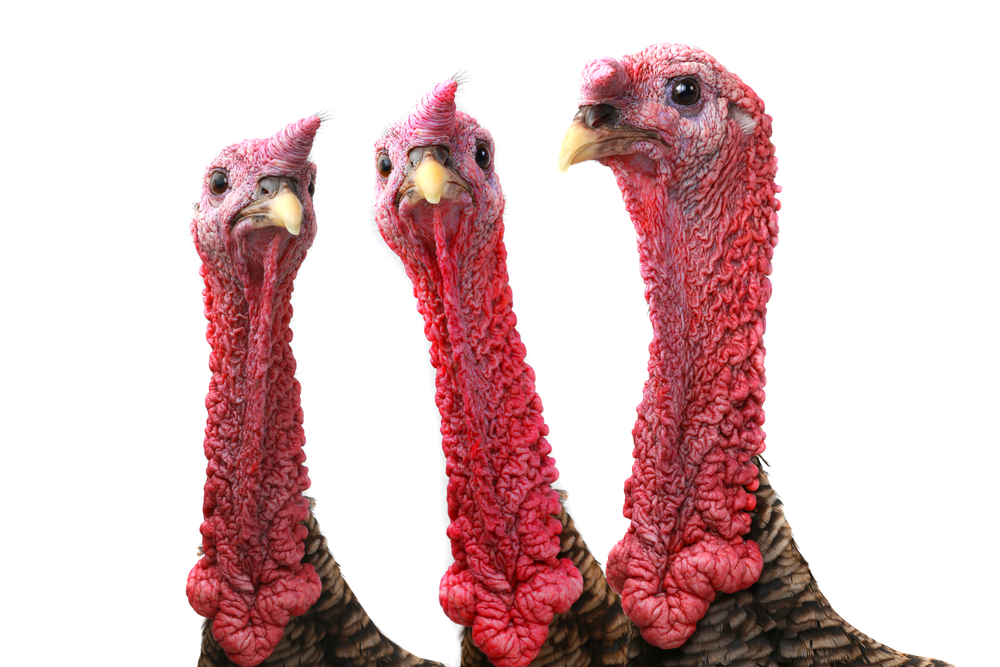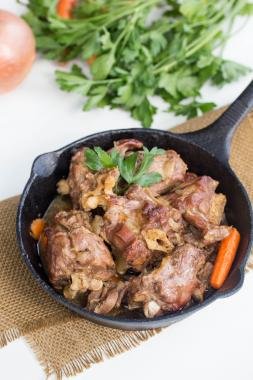Most of us cherish the food we ate as children. When I was a little girl, I loved eating chicken necks, despite them not having much meat. As an adult, I learned that turkey necks have a similar flavor and more meat!
Some of you might think I am crazy for cooking with turkey necks, but I am certain that this recipe will change your mind. Growing up in Ukraine, I was taught that every part of the animal has its place on the dinner table. When prepared properly, turkey necks are a wonderful, fall-off-the-bone comfort food!
Seared and then roasted in the oven, these turkey necks are perfect to indulge in on a cold winter day. The neck is the best part of the bird, so underrated and underutilized in cooking! Prepare some mashed potatoes or white rice to accompany the necks, or eat them fresh out of the oven all on their own.
The neck of the turkey is an often overlooked part that harbors delicious, flavorful meat. While turkey breast and legs usually get all the attention, the neck has quite a few culinary uses that can elevate your dishes. In this complete guide, we’ll cover everything you need to know about how to use turkey necks.
Anatomy of the Turkey Neck
The turkey’s neck is the part that connects the head to the body. It contains vertebrae bones as well as trachea, muscle tissue collagen, fat and skin. The neck allows flexibility and range of motion for the turkey’s head.
In terms of culinary uses, the turkey neck contains both white and dark meat. The meat is flavored throughout with collagen and fat marbling that makes it succulent when cooked.
Common Uses for Turkey Necks
There are many ways turkey necks can be utilized to add flavor and nutrition to meals:
Making Broth or Stock
One of the most popular uses for turkey necks is to make homemade broth or stock. When simmered in water with aromatics like carrots, celery, and herbs, the turkey neck bones and meat release collagen, gelatin, and nutrients into the cooking liquid. This creates a rich, mouth-coating and flavorful broth perfect for soups, stews, gravies and more. The collagen is particularly beneficial for joint health.
Adding Flavor to Beans or Greens
Turkey neck meat can be cooked until tender, then shredded or chopped to add juicy, savory flavor to dishes like simmered beans, braised greens, gumbos or rice. The flavor pairs especially well with assertive greens like collard greens, kale or mustard greens.
Stuffing Ingredient
Chopped or shredded turkey neck meat can be sautéed with aromatics as the flavor base for stuffing and dressing. The meat adds moisture and turkey flavor that balances out the starchiness.
Grilling or Roasting
Whole turkey necks can be seasoned and roasted or grilled to crispy perfection. Eaten on their own or used to embellish soups, they make a tasty, protein-rich snack.
Pet Treats
Turkey necks can be a nutritious treat for dogs. Chewing on the bones may help clean their teeth. However, necks should always be cooked, as raw turkey carries risks of salmonella.
Nutritional Benefits of Turkey Necks
While often overlooked, turkey necks provide some excellent nutritional perks:
-
High in Protein: Turkey neck meat is a great source of lean protein with around 18g per 3 ounce serving. The protein supports muscle growth and keeps you feeling full.
-
Joint-Friendly Collagen: Turkey necks contain collagen and glucosamine, compounds thatmay support joint health and flexibility. The collagen gets converted to gelatin when cooked.
-
Iron: Turkey necks provide iron which is important for oxygen transport in the blood and energy levels.
-
Zinc and B Vitamins: Zinc assists immune function while B vitamins aid metabolism.
-
Low in Saturated Fat: Compared to other meats, turkey is relatively low in saturated fat, making it a healthier choice.
How to Cook Turkey Necks
Turkey necks require slow, moist cooking methods to become tender. Here are some techniques:
-
Make Stock: Simmer necks for 2-3 hours with vegetables in water or broth. Strain out solids.
-
Braise or Stew: Brown necks then cook covered in a flavorful liquid like broth, tomatoes or wine for 1-2 hours until tender.
-
Roast: Roast seasoned necks at 400°F for 1 hour, flipping halfway. Increase time for larger necks.
-
Grill: Grill necks over medium indirect heat for about 1 hour with occasional flipping and basting.
-
Slow Cooker: Add necks to veggies, stock and seasonings. Cook on low for 7-8 hours.
-
Pressure Cook: Pressure cook necks for 30-40 minutes with natural release to get tender, shreddable meat.
The cooked neck meat will be soft, moist and easy to pull off the bones. Use it in your favorite turkey recipes!
Tips for Preparing Turkey Necks
Follow these tips when getting turkey necks ready to cook:
- Rinse necks and pat dry
- Trim off excess skin or fat
- Cut into smaller pieces if desired
- Season generously with salt, pepper and other spices or herbs
- Brown necks prior to braising, stewing or roasting
- Make sure liquid covers necks for moist braising and stewing
- Monitor and flip periodically during roasting or grilling
Where to Buy Turkey Necks
You can typically source turkey necks right from your whole turkey during the holidays. Or, ask your butcher if they have them available. For bulk amounts, try contacting a poultry supplier or local farmer.
Due to their tough texture, turkey necks used to be extremely cheap. But now that people are discovering their flavor, they have risen slightly in price but still make an economical ingredient.
Turkey Neck Recipes to Try
Here are some delicious ways to put turkey necks to work:
- Turkey Neck Stock for gravies and soups
- Braised Turkey Neck Collard Greens
- Grilled BBQ Turkey Necks
- Turkey Neck and Bean Stew
- Slow Cooker Turkey Neck Chili
- Thai Turkey Neck Curry with Vegetables
- Turkey Neck Meat Tacos or Tamales
Next time you roast a turkey, don’t discard the flavorful neck. Put it to use in nutritious, budget-friendly recipes that highlight the turkey flavor. With some cooking know-how, the turkey neck can transform from overlooked to extraordinary.

Keeping Turkey Necks Tender
The key to keeping turkey necks tender is to add a cup of hot water to your cast iron skillet (or any oven-safe skillet) before you place it in the oven. Creating a slow boil in the oven will ensure that your turkey necks do not become rubbery and burn. The added liquid will also create a yummy gravy!
Other Ways to Cook Turkey Necks
Now that you are in love with turkey necks (right?!), get creative and try cooking them differently! Here are a couple of my favorite ways to prepare turkey necks:
- Smoked Turkey Necks: Often times, you can find pre-smoked turkey necks at the butcher. These have an awesome flavor and are the perfect compliment to stews or chilis.
- Turkey Necks in a Smoked Cooker: Have a smoker at home? Smoke your own turkey necks! Set your smoker to 180F and let the necks cook for 2-4 hours, or until the meat falls off the bone. Think of these smoked necks as an adventurous departure from traditional smoked chicken wings!
- Turkey Neck Soup: My boys love turkey neck soup. Much like chicken noodle soup, it is so comforting and the perfect dish to make when someone is feeling under the weather.
- Turkey Necks Gravy: Turkey neck meat is dark, flavorful, and perfect to build a gravy from. Make a batch and smother it over just about anything!
Note: You can find turkey necks in most, large grocery stores, although not every store carries them.

How to Boil Turkey Neck & Giblets: Cooking with Kimberly
FAQ
What to do with your turkey neck?
Make Stock or Broth: The neck is great for adding flavor to homemade turkey stock. Simply simmer it with vegetables like carrots, celery, and onions, along with herbs such as thyme and bay leaves. This stock can be used for gravy or soups.
Why do they put the neck in the turkey?
“The turkey neck meat helps thicken the gravy and adds a ton of flavor,” Brooks added.
Do you use the turkey neck for gravy?
When you are ready to make your giblet gravy, place all of the neck, heart, liver, and gizzards of the turkey in a sauce pan, cover them with water and bring it to a boil. Simmer the giblets 1 hour. Remove the giblets, save the water, and chop the giblets into small pieces.
What do I do with the turkey neck and giblets?
Most often they get thrown away. My mom, who could never let anything go to waste, always used the turkey neck and giblets to make a quick pot of broth to use for making gravy or moistening stuffing. And, that’s what I do. This broth is so much more flavorful than anything that comes out of a can or box.
What is Turkey Neck good for?
Packed with succulent meat and rich in collagen, they are perfect for making savory stocks, broths, and soups. The meat on turkey necks is also exceptionally tender, with a texture that practically falls off the bone when cooked properly.
What is a wry neck?
The term “wry neck” is a non-medical description of a condition called torticollis. Torticollis is a twisting of the neck that leaves the head turned or tilted to one side, often with an inability to move the head. The cause is unknown and can be present at birth, presumably related to the position of the fetus in the womb that affects the neck muscles. Other potential causes include sleeping in an unusual position, viral infection, or injury. Neck spasm or scarring of the skin or muscles around the neck (as may occur with burn injuries) may lead to torticollis.
What is turkey neck meat?
Unlike those larger muscle groups, turkey neck meat consists of numerous small muscles — once cooked, it transforms into tender, juicy shreds that can be lifted from the bones, making it a versatile addition to a wide range of recipes.
What can you do with turkey neck meat?
Turkey neck can be used as a shredded addition to beans, soups, and sauteed greens, or served on the bone, smothered in richly flavored sauce. But the culinary magic doesn’t end there: The simmering liquid used to cook the turkey neck meat becomes rich bone broth, brimming with nutrients.
Should you eat turkey neck meat?
Neck meat is a flavorful choice if you want a touch more indulgence while still maintaining the nutritional value of turkey. According to NutritionValue.org, turkey necks share a similar nutrition profile to other dark meat from the bird.
Should a turkey neck be removed from the body?
If you’re buying a farm-fresh turkey, the neck might even be still attached at the head end. A careful cut at the base of the turkey will remove the neck — it should be cooked separately from the body for best results anyway. If you just have one turkey neck, you’ve got enough meat to flavor simmered greens or a batch of grits.
